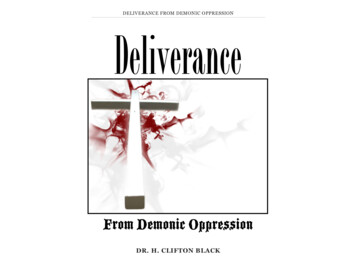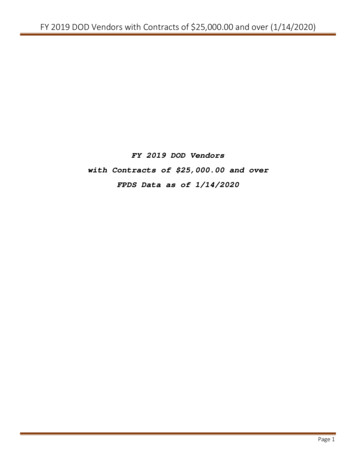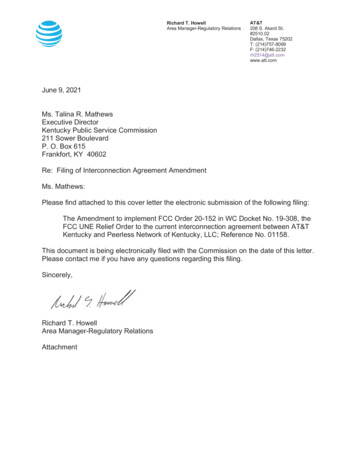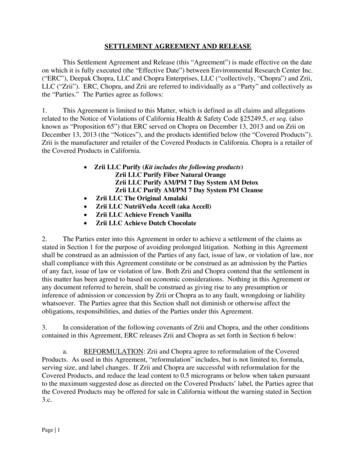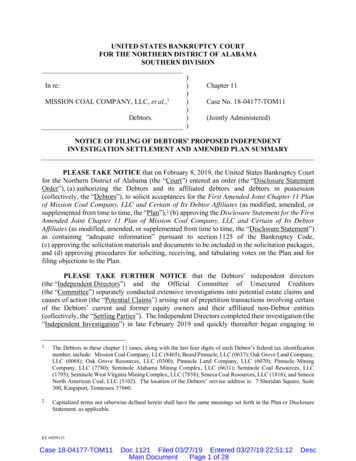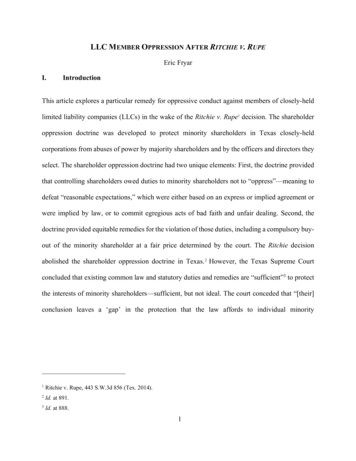
Transcription
LLC MEMBER OPPRESSION AFTER RITCHIE V. RUPEEric FryarI.IntroductionThis article explores a particular remedy for oppressive conduct against members of closely-heldlimited liability companies (LLCs) in the wake of the Ritchie v. Rupe1 decision. The shareholderoppression doctrine was developed to protect minority shareholders in Texas closely-heldcorporations from abuses of power by majority shareholders and by the officers and directors theyselect. The shareholder oppression doctrine had two unique elements: First, the doctrine providedthat controlling shareholders owed duties to minority shareholders not to “oppress”—meaning todefeat “reasonable expectations,” which were either based on an express or implied agreement orwere implied by law, or to commit egregious acts of bad faith and unfair dealing. Second, thedoctrine provided equitable remedies for the violation of those duties, including a compulsory buyout of the minority shareholder at a fair price determined by the court. The Ritchie decisionabolished the shareholder oppression doctrine in Texas. 2 However, the Texas Supreme Courtconcluded that existing common law and statutory duties and remedies are “sufficient”3 to protectthe interests of minority shareholders––sufficient, but not ideal. The court conceded that “[their]conclusion leaves a ‘gap’ in the protection that the law affords to individual minority1Ritchie v. Rupe, 443 S.W.3d 856 (Tex. 2014).2Id. at 891.3Id. at 888.1
shareholders,”4 and the possibility remains that a “proper case might justify [the] recognition of anew common-law cause of action to address a ‘gap’ in protection for minority shareholders.”5I have argued elsewhere that the reasoning in Ritchie allows, and even encourages, thedevelopment of existing common-law principles to fill the gap left by the Ritchie opinion.6 I haveargued for the enforcement of quasi-fiduciary duties that corporations owe to individualshareholders in a breach of trust cause of action, which would permit a buy-out remedy,7 and forliberal application of the tort of conversion to stock in closely-held corporations for which thedamages recoverable are the functional equivalent of a buy-out.8 In this article, I consider theshareholder oppression doctrine in the context of LLCs. I briefly examine the nature of LLCs, thephenomenon of shareholder oppression in closely-held corporations, and the correspondingphenomenon of minority member oppression in closely-held LLCs. I then recap the developmentof the shareholder oppression doctrine and its application to LLCs and describe the basis andimplications of the Ritchie decision. Finally, I explore the viability of applying section 11.314 ofthe Texas Business Organizations Code (TBOC) to LLC member oppression—a statute not4Id. at 889.5Id. at 890.6Eric Fryar, Filling in the Gaps: Shareholder Oppression After Ritchie v. Rupe: Part 1, 47:1 TEX J. BUS. L. 49, 83–84 (2017) [hereinafter Fryar, Part 1].7Id. at 51.8Eric Fryar, Filling in the Gaps: Shareholder Oppression Aftter Ritchie v. Rupe: Part 2, 47:2 TEX J. BUS. L. 1, 77(2018), -ritchie-v-rupe-part-2.2
applicable to corporations9 and not considered by the Ritchie court. I argue that Texas may stillhave a viable oppression cause of action for members of closely-held LLCs under section 11.314.10In short, and as will be developed below, the shareholder oppression doctrine was grounded insection 11.404 of the TBOC. This statute provided for the appointment of a receiver and possibilityof liquidation if the actions of the governing persons were “illegal, oppressive, or fraudulent.”11Texas courts developed a broad definition of “oppressive” that described a range of wrongfulconduct in closely-held corporations. The courts invoked their general equitable powers to fashionappropriate remedies, including the compulsory buy-out of the oppressed shareholder’s stock. TheTexas Supreme Court held that the receivership statute did not provide a buy-out remedy and didnot permit courts to use their equitable powers to fashion other remedies. However, there is afunctionally similar statute that applies only to partnerships and LLCs that provides for windingup and termination of those entities.12 This statute does not require a finding of oppression butinstead provides relief for conduct and circumstances that either frustrate the economic purpose ofthe entity or make the carrying on of the business not reasonably practicable. Analysis of the textof the statute, of the few Texas cases dealing with the statute, and of the many cases from otherjurisdictions interpreting similar text reveals that the statute applies to conduct and fact patternsthat would have been considered oppressive under the shareholder oppression doctrine.9See TEX. BUS. ORGS. CODE ANN. § 11.314 (West, Westlaw through 2017 Reg. Legis. Sess.). The statute is applicableonly to limited liability companies and to general and limited partnerships. Id.10I should point out that the common-law causes of action for breach of trust and conversion are almost certainlyavailable in the limited liability company context, but that discussion is beyond the scope of this article.11BUS. ORGS. § 11.404–05 (Westlaw).12See id. § 11.314.3
Furthermore, the LLC statute is not limited to a single remedy and therefore permits courts to usetheir equitable powers to fashion an appropriate remedy—such as a compulsory buy-out.II.Texas Limited Liability CompaniesA.Nature of Limited Liability CompaniesThe limited liability company is a relatively new creation in business organizations law.13 The LLCwas designed to answer the need for a business entity that combined limited liability (like acorporation) with pass-through taxation (like a general or limited partnership).14 Wyoming was thefirst state to effect a statute allowing the creation of LLCs, which passed in 1977.15 Texas becameone of only eight states to have recognized this new form of business organization, when the TexasLimited Liability Company Act16 became effective on August 26, 1991.17 By 1996, however, everyU.S. jurisdiction had LLC statutes.18 Texas LLC law is now codified in the TBOC, particularlychapter 101.19 Texas remains committed to staying on the cutting edge of the development of LLClaw.2013See Susan Pace Hamill, The Origins Behind the Limited Liability Company, 59 OHIO ST. L. J. 1459, 1459 (1998).14See id. at 1460.15Id.16Texas Limited Liability Company Act of 1992, TEX. REV. CIV. STAT. ANN. art. 1528n. (West, Westlaw through2017 Reg. Legis. Sess.) (expired Jan. 1, 2010).17ELIZABETH S. MILLER & ROBERT A. RAGAZZO, 19 TEXAS PRACTICE SERIES, BUSINESS ORGANIZATIONS § 18:2 (Oct.2018), Westlaw 19 TXPRAC § 18:2 [hereinafter MILLER & RAGAZZO, 19 TEXAS PRACTICE SERIES].18Id.19See TEX. BUS. ORGS. CODE ANN. § 101.001 (West, Westlaw through 2017 Reg. Legis. Sess.).20See MILLER & RAGAZZO, 19 TEXAS PRACTICE SERIES, supra note 17, § 18:5.4
LLCs are attractive organizational vehicles for many types of closely-held businesses.21 In lessthan three decades since its widespread adoption, the LLC has grown to be a more frequent choiceof business organization than corporations, limited partnerships, and limited liabilitypartnerships.22B.Organizational Structure of LLCsThe LLC is a hybrid entity, possessing both corporate and partnership features.23 However, LLCsare distinct organizations and are neither corporations24 nor partnerships.25 Like a corporation andunlike a partnership, an LLC may have one sole owner;26 the members are not responsible for thedebts and obligations of the company;27 and the members may participate in management withoutlosing limited liability. 28 Management of an LLC may be structured like a corporation, withmanagers functioning like directors of a corporation, or like a partnership in which the members21Id. § 18:2.22Id.23Id. § 18:3.24See Alta Mesa Holdings, L.P. v. Ives, 488 S.W.3d 438, 453 (Tex. App. 14th 2016) (holding that attorney’s fees arenot recoverable against an LLC under section 38.001 of the Texas Civil Practice and Remedies Code because thatprovision permits recovery of attorney’s fees from an individual or corporation and an LLC is not an individual orcorporation); see also CBIF Ltd. P’ship v. TGI Friday’s Inc., 05-15-00157-CV, 2017 WL 1455407, at *14 (Tex. App.5th 2017).25See SJ Med. Ctr., L.L.C. v. Estahbanati, 418 S.W.3d 867, 874 (Tex. App. 14th 2013) (rejecting LLC’s argumentthat it should be considered a partnership for purposes of a provision of the Texas Health and Safety Code defining a“hospital district management contractor” as “a nonprofit corporation, partnership, or sole proprietorship that managesor operates a hospital or provides services under contract with a hospital district that was created by general or speciallaw”).26See, e.g., TEX. BUS. ORGS. CODE ANN. § 101.001(1) (West, Westlaw through 2017 Reg. Legis. Sess.) (“A companyagreement of a limited liability company having only one member is not unenforceable because only one person is aparty to the company agreement.”).27Id. § 101.114.28Limited partners are not liable for partnership obligations so long as they do not participate in management. BUS.ORGS. § 152.102 (Westlaw). However, active participation in management forfeits the limited liability protection. SeeHumphreys v. Medical Towers, Ltd., 893 F.Supp. 672, 688 (S.D. Tex. 1995), aff’d 100 F.3d 952 (5th Cir. 1996).5
manage the company directly without managers.29 On the other hand, ownership of an LLC followsthe partnership model, in that transferees of ownership interests do not become members with therights of membership (primarily the right to vote) unless all other members consent.30The most distinctive feature of the LLC business form is the company agreement. The LLC statuteis designed to allow owners maximum flexibility in devising their own company structures andrules.31 While the TBOC provides many norms and regulations, most are only default provisions,and virtually all of them are subject to modification in the company agreement.32 As a result, “[t]heLLC’s model of contractual freedom is found in few other places in the world.”33C.Governance Issues Unique to LLCs1.Governing DocumentsThe certificate of formation 34 and the company agreement are the governing documents of anLLC.35 The certificate is required to state whether the LLC will be governed by its members or bydesignated managers.36 The TBOC contemplates that the company agreement will set forth allmatters relating to the governance of the LLC and the relations of its members;37 however, anything29BUS. ORGS. § 101.251 (Westlaw).30See id. § 101.109.31See id. §§ 101.052, 101.252.32Id. § 101.054.33William J. Carney, Limited Liability Companies: Origins and Antecedents, 66 U. COLO. L. REV. 855, 861 (1995).34BUS. ORGS. § 1.002(36) (Westlaw).35Id. § 101.052.36Id. § 3.010.37See id. §§ 101.052–.054; 101.252.6
that may be included in a company agreement may also be stated in the certificate.38 In the eventof a conflict between the certificate and the agreement, the certificate controls.39The TBOC provides that all members must agree to the company agreement, and all membersmust agree to any amendment. 40 Similarly, any amendment or restatement of the certificaterequires a unanimous vote of the members.41 However, these requirements may be modified in thecertificate or company agreement.42 The TBOC provides that a single member LLC may executean enforceable company agreement.43 Persons who join the LLC as members after its inceptionare bound by the existing certificate and company agreement and are required to exercise diligencein obtaining and understanding the contents of the certificate and company agreement.44There is no requirement that an LLC have a company agreement or that a company agreementcover all the possible topics.45 If the LLC fails to execute a company agreement or fails to address38Id. § 101.051.39Id. § 101.052(d); see also Pinnacle Data Servs, Inc. v. Gillen, 104 S.W.3d 188, 195 (Tex. App. 6th 2003),disapproved on other grounds by Ritchie v. Rupe, 443 S.W.3d 856 (Tex. 2014).40BUS. ORGS. § 101.001(1); 101.053 (Westlaw).41Id. § 101.356.42Id. § 101.054.43Id. § 101.001(1).44See Pinnacle Data Servs, 104 S.W.3d at 195 (“The terms set forth in the Regulations, Articles, and the TLLCA arenot rendered inoperative because PDS failed to exercise diligence in obtaining a copy of the Articles before agreeingto their terms.”).45Cf. Advanced Orthopedics, L.L.C. v. Moon, 656 So. 2d 1103, 1105–06 (La. Ct. App. 1995) (stating there is norequirement under the Louisiana LLC statute that an LLC have an operating agreement—the equivalent to a companyagreement in Texas—to be viable).7
a matter in the company agreement, the default provisions of the TBOC will supplement or evenfunction as the company agreement.462.Member ManagementLimited liability companies may be member-managed or manager-managed. 47 In a membermanaged LLC, the members operate the business directly as in a partnership.48 In a managermanaged LLC, the members elect managers who then run the business—similar to shareholdersand directors in a corporation.49 Significant confusion can sometimes exist in member-managedLLCs because the members in such an organization are also the governing persons, with all therights, powers, and liability that accompany that responsibility.50 For example, under the TBOC,the rights of members to inspect company records are somewhat limited;51 however, when themembers are also governing persons, they have virtually unlimited information rights.52 Individualmembers in a manager-managed LLC probably owe no duties to the company; however, when themembers manage the LLC, they almost certainly do.46BUS. ORGS. § 101.052(b) (Westlaw) (“To the extent that the company agreement of a limited liability company doesnot otherwise provide, this title and the provisions of Title 1 applicable to a limited liability company govern theinternal affairs of the company.”).47Id. § 101.251.48Id. § 1.002(35)(A).49Id.50Id. § 1.002(37).51See id. § 101.502.52See id. § 3.152.8
3.VotingAnother area that can cause significant confusion is voting. Under the default provisions of theTBOC, every member and every manager has an equal vote. 53 This may be changed in thecertificate or company agreement,54 but it is often overlooked. Therefore, a two-member, membermanaged LLC may find itself hopelessly deadlocked, even when one member owns 90% of theequity and the other member owns only 10%.4.Fiduciary Duties in an LLCTexas courts generally hold that governing persons in an LLC owe fiduciary duties to the companyin the same way that directors owe fiduciary duties to a corporation.55 Generally, no fiduciaryduties are owed by members of an LLC to each other.56 However, some courts have recognized aninformal fiduciary duty between manager-members who control the LLC and non-controlling53Id. § 101.354.54Id. § 101.054.55See Pinnacle Data Servs., Inc. v. Gillen, 104 S.W.3d 188, 198–99 (Tex. App. 6th 2003) (holding LLC managersowe fiduciary duties based on the “well established [principle] that the directors of a corporation stand in a fiduciaryrelationship to the corporation and its stockholders, and they are without authority to act in a matter in which adirector's interest is adverse to that of the corporation.”), disapproved of on other grounds by Ritchie v. Rupe, 443S.W.3d 856 (Tex. 2014); see also In re Hardee, No. 11-60242, 2013 WL 1084494, at *9 (Bankr. E.D. Tex. Mar. 14,2013) (“Though limited liability companies are not corporations in the strictest sense, and though Texas law implies,but does not explicitly state, that the fiduciary status of corporate officers and directors and the corresponding threebroad duties of such corporate officers and directors—the duty of due care, loyalty, and obedience—applies tomanagers and/or members governing the activities of a limited liability company, the imposition of those duties uponthe management of a limited liability company under Texas law is appropriate and warranted.”).56Allen v. Devon Energy Holdings, L.L.C., 367 S.W.3d 355, 391 (Tex. App. 1st 2012) (“[W]e do not agree with Allenthat Texas recognizes a broad formal fiduciary relationship between majority and minority shareholders in closelyheld companies that would apply to every transaction among them. We therefore decline to recognize such a fiduciaryduty between members of an LLC on this basis.”); Vejara v. Levior Int’l, LLC, No. 04-11-00595-CV, 2012 WL5354681, at *4 (Tex. App 4th. Oct. 31, 2012) (“Texas does not recognize a broad formal fiduciary relationship betweenmajority and minority shareholders in closely-held companies.”).9
members based on the controlling member’s intimate knowledge of the company’s affairs. 57Moreover, one court has recognized a formal fiduciary duty owed by a majority member to aminority member in the limited circumstance of negotiating the redemption or purchase of theminority member’s ownership.58III.Rise and Fall of the Shareholder Oppression Doctrine59A.Oppressive Conduct in Closely-Held CorporationsIn a corporation, whoever votes the majority of the shares exercises total control over who runsthe corporation.60 These majority shareholders almost always vote themselves and their friends andfamily to the board of directors.61 In closely-held corporations, where the number of shares andshareholders is small, majority ownership of shares by one person or a small group is the norm.62Minority shareholders in these corporations have only that amount of control over the corporationthat the majority permits.57Vejara, 2012 WL 5354681, at *5 (holding that “Vejara's control and intimate knowledge of the company’s affairsand plans gave rise to the existence of an informal fiduciary duty to Levior.”); Guevara v. Lackner, 447 S.W.3d 566,581 (Tex. App. 13th 2014) (reversing a summary judgment on breach of fiduciary duties against a majority memberbased on “intimate knowledge of L & L Importers’ daily affairs and plans as reflected in the evidence before thisCourt. There is evidence that Dr. Guevara did not have such extensive knowledge of L & L Importers’ operations;that he was not involved in the day-to-day operations of the company.”).58See Allen, 367 SW3d at 395–96 (“We conclude that there is a formal fiduciary duty when (1) the alleged-fiduciaryhas a legal right of control and exercises that control by virtue of his status as the majority owner and sole membermanager of a closely-held LLC and (2) either purchases a minority shareholder’s interest or causes the LLC to do sothrough a redemption when the result of the redemption is an increased ownership interest for the majority owner andsole manager.”).59See generally Fryar, Part 1, supra note 6, at 58–84.60Id. at 52–53.61See Douglas Moll, Majority Rule Isn’t What It Used To Be: Shareholder Oppression in Texas Close Corporations,63 TEX. B.J. 434, 436 n.4 (2000) [hereinafter Moll, Majority Rule].62See id. at 436.10
Closely-held corporations usually involve a small group of people working closely together oftenin stressful situations—with all the accompanying potential for interpersonal conflict and drama.63As the Texas Supreme Court noted in Ritchie v. Rupe: “Occasionally, things don’t work out asplanned: shareholders die, businesses struggle, relationships change, and disputes arise. When, asin this case, there is no shareholders’ agreement, minority shareholders who lack both contractualrights and voting power may have no control over how those disputes are resolved.”64Shareholders in small companies usually work in the company. Most of their personal wealth istied up in the company. They are dependent upon salary, distributions from the company, or bothto make a living. When a dispute arises, the majority shareholder will often attempt to “squeezeout” the minority member.65 The squeeze out usually begins with firing the minority shareholderand refusing to declare dividends so the minority shareholder gets no economic benefit from shareownership.66 In a subchapter-S corporation, the minority shareholder may continue to owe taxeson corporate earnings, even though he receives nothing.67 Usually, the majority shareholder alsoadds insult to injury by voting the minority shareholder out as a director, cutting off access toinformation about the company, and refusing to hold shareholder meetings.6863Id.64Ritchie v. Rupe, 443 S.W.3d 856, 878–79 (Tex. 2014).65Id. at 894 (Guzman, J., dissenting).66See Moll, Majority Rule, supra note 61, at 436.67See Fryar, Part 1, supra note 6, at 188.68Douglas K. Moll, Shareholder Oppression in Texas Close Corporations: Majority Rule (Still) Isn’t What It Used toBe, 9 HOUS. BUS. & TAX. L. J. 33, 36 (2008).11
The minority shareholder is trapped in an oppressive situation and will be forced to sell to themajority shareholder at a price dictated by the majority. If the minority does not sell, then he willbe subject to a “freeze out,” in which his share ownership is simply ignored as irrelevant.69[M]inority shareholders in closely-held corporations have ‘no statutory right to exitthe venture and receive a return of capital’ like partners in a partnership do, and‘usually have no ability to sell their shares’ like shareholders in a publicly-heldcorporation do. Unhappy with the situation and unable to change it, [minorityshareholders] are often unable to extract themselves from the business relationship,at least without financial loss.70The frozen-out minority will receive no benefits, no information, and no opportunity to participateas a shareholder.Oppressive conduct is effective in closely-held corporations because of majority rule and theabsence of an exit.A wielding of this power by any group controlling a corporation may serve todestroy a stockholder’s vital interests and expectations. As the stock of closely-heldcorporations generally is not readily salable, a minority shareholder at odds withmanagement policies may be without either a voice in protecting his or her interestsor any reasonable means of withdrawing his or her investment.71The Ritchie court reasoned that shareholders may protect themselves by drafting shareholderagreements “that contain buy-sell, first refusal, or redemption provisions that reflect their mutualexpectations and agreements.”72 However, shareholder agreements that address future problemsnot anticipated at the founding of the company are exceedingly rare. The dissenting opinion inRitchie aptly noted: “From a relational standpoint, people enter closely-held businesses in the same69See id.70Id.71In re Kemp & Beatley, Inc., 473 N.E.2d 1173, 1179 (N.Y. 1984).72Ritchie, 443 S.W.3d at 871.12
manner as they enter marriage: optimistically and ill-prepared.” 73 Owners of closely-heldcorporations usually trust each other, at least at the outset of the venture, and regard contractualprotection as unnecessary.74Without legal protection, minority ownership in a closely-held corporation can become essentiallya joke—in other words: “There are 51 shares . . . that are worth 250,000. There are 49 shares thatare not worth a .”75 The Texas Supreme Court acknowledged: “Closely-held corporationshave unique attributes that may justify different protections under the law.”76Prior to Ritchie, Texas courts had come to recognize that they must “take an especially broad viewof the application of oppressive conduct to a closely-held corporation, where oppression may moreeasily be found,” and must use their equitable powers to protect the minority shareholders whofind themselves on the receiving end of a squeeze out.77 The majority opinion in Ritchie alsoacknowledged:Our review of the case law and other authorities also convinces us that it is bothforeseeable and likely that some directors and majority shareholders of closely heldcorporations will engage in such actions with a meaningful degree of frequency andthat minority shareholders typically will suffer some injury as a result. Althoughthe injury is usually merely economic in nature, it can be quite substantial from theminority shareholder’s perspective, as it often completely undermines their sole orprimary motivation for engaging with the business. We thus conclude that theforeseeability, likelihood, and magnitude of harm sustained by minorityshareholders due to the abuse of power by those in control of a closely held73Id. at 894 (Guzman, J., dissenting) (quoting Charles W. Murdock, The Evolution of Effective Remedies for MinorityShareholders and Its Impact Upon Valuation of Minority Shares, 65 NOTRE DAME L. REV. 425, 426 (1990)).74Douglas K. Moll, Minority Oppression & the Limited Liability Company: Learning (or Not) from Close CorporationHistory, 40 WAKE FOREST L. REV. 883, 912 (2005) [hereinafter Moll, Minority Oppression].75Humphrys v. Winous Co., 133 N.E.2d 780, 783 (Ohio 1956).76Ritchie, 443 S.W.3d at 864 n.8.77See Davis v. Sheerin, 754 S.W.2d 375, 381 (Tex. App. 1st 1988).13
corporation is significant, and Texas law should ensure that remedies exist toappropriately address such harm when the underlying actions are wrongful.78B.Oppression in Limited Liability CompaniesMinority owners in small limited liability companies may be oppressed in the same manner andfor the same reasons as minority owners in corporations. 79 Manager-managed LLCs are littledifferent from corporations from an operational standpoint. Members have no managementauthority but elect managers to run the business, just like shareholders in a corporation vote fordirectors who run the business.80 Usually, the person or group holding a majority ownership in anLLC will have control over the selection of managers.81 In a member-managed LLC, majoritymembers usually make sure that they have management control.Members of closely-held LLCs are vulnerable to oppression just as shareholders are vulnerable inclosely-held corporations. Members in closely-held LLCs usually work together with a smallnumber of other members, making interpersonal conflicts that may develop into ownership issues.Majority rule grants some members control over 100% of the management decisions. Thesemembers decide who to hire and fire, whether and how much to distribute, and who gets whatinformation about the business. Majority members in closely-held LLCs have the same temptationsto abuse that power. Finally, LLC members, like stockholders, ordinarily have no exit and thus,78Ritchie, 443 S.W.3d at 879.79See generally Moll, Minority Oppression, supra note 75, at 895–96. Virtually all LLCs are closely held—meaningthey have few members who are personally involved in running the company. Id. at 883. It is theoretically possible tohave a publicly held LLC. Currently, they are exceedingly rare. Id. at 925–26.80Id. at 917–18.81See id. at 945–46 (“LLC statutes generally provide that a majority vote of the members is needed to elect (as wellas to remove) a manager.”).14
no ability to escape the trap of oppressive conduct other than to sell at an unfairly low price. 82Professor Douglas Moll refers to these factors as the “seeds” of oppression83 and notes that “theproblem of oppression is ‘portable’ to the LLC context.”84Thus, majority LLC members have the ability to oppress minority members in exactly the samemanner as in corporations. Members controlling the LLC might exclude the oppressed memberfrom participation, cut off information, divert profits away from the minority member, andterminate the minority member’s employment. Majority members can then use their economicleverage to squeeze out the minority by forcing them to sell at an unfair price or to freeze them outby denying them all benefits of ownership and pretending they do not exist.Minority members of LLCs are also just as able to protect themselves contractually as shareholdersin a corporation—perhaps more so given the importance of the company agreement in LLCgovernance.85 However, LLC members are just as trusting of their friends and family and are justas naïve as shareholders;86 therefore, effective contractual protection against oppression is as rarein the LLC as it is in the corporation.82TEX. BUS. ORGS. CODE ANN. § 101.107 (West, Westlaw through 2017 Reg. Legis. Sess.) (“A member of a limitedliability company may not withdraw or be expelled from the company.”).83Moll, Minority Oppression, supra note 75, at 956. “Although generalizations are dangerous due to the wide varietyof LLC statutes, the “seeds” of oppression are, in many jurisdictions, present in the LLC setting.” Id.84Id. at 896.85See BUS. ORGS. § 101.252 (Westlaw).86Moll, Minority Oppression, supra note 75, at 956. “In short, the factors that contribute to a failure to effectivelycontract for protection in the close corporation are likely to produce the same outcome in the LLC. Those factors stemprimarily from the traits of small business owners and the small business setting itself, rather than from thecharacteristics of the legal structure that is used to conduct the business.” Id.15
C.The Shareholder Oppression Doctrine1.The “Oppression Statute”87The so-called oppression statute is codified at section 11.404 of the TBOC. 88 This statutepermits a district court to appoint a receiver at the request of an individual shareholder upon ashowing that “the actions of the governing persons of the entity are illegal, oppressive orfraudulent.”89 Section 11.404(b)(3) prohibits appointing a receiver unless the court determines thatall other available legal and equitable remedies are inadequate. 90 Significantly, the term“oppressive” is not defined, and the only remedy explicitly granted is a receivership—generallyconsidered a drastic or harsh remedy and seldom to be used.91 Prior to Ritchie, very little case lawexisted interpreting this statute.2.Shareholder Oppression Cause of ActionIn the 1980s, Texas courts b
the Texas Business Organizations Code (TBOC) to LLC member oppression—a statute not 4 Id. at 889. 5 Id. at 890. 6 Eric Fryar, . the LLC statute is not limited to a single remedy and therefore permits courts to use . 16 Texas Limited Liability Company Act of 1992, TEX. REV. CIV. STAT. ANN. art. 1528n. (West, Westlaw through

